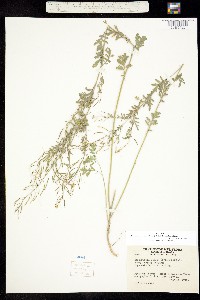Descurainia obtusa
|
|
|
|
Family: Brassicaceae
Blunt Tansy-Mustard, more...blunt tansymustard, blunt tansy mustard
[Sophia obtusa Greene] |
Biennials; glandular or eglandular; finely pubescent, often canescent, trichomes dendritic, sometimes mixed with simple ones. Stems erect, unbranched basally or branched proximally and/or distally, 4-12(-15) dm. Basal leaves: petiole 0.5-3.7 cm; blade pinnate, oblanceolate to obovate or ovate in outline, 1-6 cm, lateral lobes (2-5 pairs), oblanceolate to linear or narrowly lanceolate, (7-25 × 2-10 mm), margins usually entire or serrate, rarely incised, (apex obtuse). Cauline leaves sessile or shortly petiolate; blade smaller distally, distal lobes often narrower, surfaces densely pubescent. Racemes considerably elongated in fruit. Fruiting pedicels ascending to divaricate, straight, 6-15 mm. Flowers: sepals spreading or sometimes ascending, greenish to yellowish, oblong, 1-2 mm, densely pubescent, (trichomes dendritic, sometimes mixed with glandular papillae); petals oblanceolate, 1-2 × 0.5-0.7 mm (equaling or shorter than sepals); median filaments 1.4-2 mm; anthers 0.2-0.3 mm. Fruits divaricate to suberect, linear, slightly torulose, 10-20 (-23) × 0.7-1 mm, (acute at both ends); valves each with distinct midvein, (sparsely to densely pubescent); septum not veined; ovules 16-40 per ovary; style 0.1-0.2 mm, glabrous. Seeds uniseriate or biseriate, light brown, oblong, 0.7-1.1 × 0.5-0.6 mm. 2n = 14. Flowering May-Sep(-Oct). Gravelly grounds, sandy areas, disturbed sites, open forests, plateaus, abandoned mine areas, dry streams and washes; 1500-2600 m; Ariz., Nev., N.Mex.; Mexico (Baja California). As circumscribed here, Descurainia obtusa is a relatively uniform, diploid species. It probably was involved as a parent of D. adenophora, which is a hexaploid readily distinguished by characters discussed thereunder.
Martin and Hutchins 1980, Kearney and Peebles 1969, FNA 2010, Allred and Ivey 2012 Duration: Annual Nativity: Native Lifeform: Forb/Herb General: Biennial (sometimes annual) herbs, 50-120 cm tall, from a taproot; stems erect, branching, finely pubescent or white-woolly (canescent), the hairs simple or branching. Leaves: Basal leaves on petioles, withering before flowering; stem leaves alternate, sessile or short-petiolate; blades once or twice pinnatifid, 1-6 cm long, with 2-5 pairs of linear or lanceolate, entire or toothed ultimate segments, white woolly. Flowers: Whitish to pale yellow in terminal racemes, on 6-15 mm long pedicels which are ascending in flower and ascending to widely spreading when in fruit; sepals 4, spreading or ascending, yellowish to greenish, 1-2 mm long, densely and finely pubescent; petals 4 in a cross formation, about 2 mm long, whitish to pale yellow. Fruits: Capsules linear, 1-2 cm long and 1 mm wide, ascending to erect, slightly constricted between the seeds, pubescent when young; seeds 1 mm long, oblong, light brown, usually in 1 row per locule. Ecology: Found in canyons and arroyos at lower elevations, and on slopes and open ground at higher elevations, from 3,500-8,000 ft (1067-2438 m); flowers April-September. Distribution: AZ, NV, NM; south to Baja Calif., MEX Notes: Descurainia is a genus of weedy-looking mustards with feathery, pinnately lobed leaves, racemes of inconspicuous white to yellow flowers, and narrow seed pods. The raceme is compact when in flower and then expands substantially in fruit so that the seed pods are well-spaced along the stalk. To distinguish among the various species of Descurainia, focus on the shape, size, and orientation of the seed pods. D. obtusa has straight, narrow (1 mm wide), linear seed pods 1-2 cm long which are slightly constricted between the seeds and can be horizontal or upward pointing. D. pinnata has seed pods which are a bit wider and rounded at the tip compared to the base (clavate, or club-shaped), about 1 cm long, not constricted between the seeds, and the pods point upwards even though the pedicels tend to be more horizontal or only slightly upward pointing. D. sophia is more similar to D. obtusa; like D. obtua it has ascending-spreading pods which are narrow and slightly constricted between the seeds; however the pods are glabrous, tend to be slightly longer (1.5- 3 cm long), and the pods themselves tend to curve a bit upward at maturity (D. obtusa has almost completely straight pods). FNA does not recognize any subspecies for D. obtusa. Subsp. adenophora was formerly recognized, but that taxon is now considered its own species of hybrid origin, with D. obtusa as a parent. D. adenophora has seeds in 2 rows per locule and longer fruiting pedicels, 13-31 mm long (D. obtusa usually has seeds in 1 row per locule and fruiting pedicels 6-15 mm long). Ethnobotany: The young plants were boiled or eaten raw as greens. Etymology: Descurainia is named for French pharmacist and botanist Franscois Descourain (1658-1740); obtusa means blunted, possibly referring to the obtuse tips on the leaf lobes. Editor: SBuckley 2010, AHazelton 2017 |




















































































